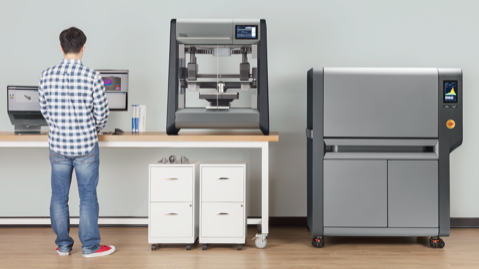
The Desktop Metal Studio machine – filament based metal particles held in a plastic filament, creating green parts ready for curing – with easy removable supports
Additive manufacturing and 3D CAD dream team lift the veil on technology that has gained $100million in venture capital (from the likes of Google, BMW) – and it’s as good as you thought it might be.
With an executive team that reads like a who’s who of the 3D CAD and additive manufacturing industry, no surprise then that the jungle drums have been beating about Desktop Metal and its metal printing process for some months now.
Founded by Ric Fulop, one of the lead investors in not only Protolabs, but also Onshape and Markforged, but also luminaries from the MIT (who invented not only binder jetting build process – central to the likes of Z Corp, X-Jet and many more) but also metal injection moulding) and the inventor of eDrawings, Desktop Metal has finally announced what it has been working on since 2015.

Cartridge loading system for the Desktop Metal Studio build machine – snap in/snap out
The core technology is the creation of 3D printed metals using a combination of either FDM style deposition or powder and binder. The reason for the bifurcated approach is that Desktop Metal’s products focus on two core areas – at the desktop and the production level. Let’s deal with the desktop, design and engineering studio focussed product first.
The office focussed set-up, Desktop Metal Studio, is based on a proprietary filament that holds the metal particles together and is built in a desktop sized machine. It’ll allow you to build reasonably sized parts (300mm x 200mm x 200mm) parts.
The production intent machine is a much larger beast, using jetted binder and powder based approach to building chambers of parts. It was full-width printheads and is capable of seriously fast production rates of 8,200cm2 per hour in a 330 x 330 x 300 build chamber.

Desktop Metal’s Production system – powder bed and jetted bindber to build production parts – damn quick
Both variants use their processes to create ‘green’ parts which are then sintered using the same microwave-based furnaces to solidify them (typically referred to as sintering). What’s unique (and subject to 100+ patents due to be published in the next few months) is that the whole process works without the heavy, industrialised set-up that is associated with traditional metals sintering process, such as DMLS or SLS.
There are no extraction or powder handling requirements – the machines are self-contained in two units (for build machine and the furnace for sintering). There’s also a huge reduction in the post processing required.

The Desktop Metal Studio product – part and support material is the same, but there’s a ceramic layer that enables super quick adn clean support breakaway – no bandsaws or wire EDM here
Desktop Metal’s Studio product process uses the same material for support as it does for build, but with a ceramic layer between the two portions. This makes removal of the supports dramatically simpler and quicker and without the need for wire EDM. The production machines use powder-bed approach, so there aren’t the same concerns with support removal, as the parts are self supporting.
In terms of materials available, here’s where things get very interesting.
Rather than relying on specialised, highly proprietary metal powders, Desktop Metal has leveraged the global Metal Injection Moulding (MIM) market and built its processes to use these existing powders in its two processes. This means that there’s a much larger choice of materials available and they’re dramatically cheaper (as the market is much larger).
While the machine specs look incredible, what’s really going to panic a few folks at traditional sintering machine vendors is the price.
The desktop machine is $49,000 for the build machine and an additional $60,000 for the furnace – or it’s available as a ‘Hardware as a Service’ (HaaS) for $3,250 per month.
Compared to the cost of investing in smaller sintering machines and all of the ancillary costs, this represents a huge change in the entry point into the metals part production game.
The costs for the production machine are higher ($360,000 for the build machine – same microwave furnace), but again, the removal of all of the ancillary processes and facilities, makes this much more economically viable – particularly for those looking for production scale capability.
We’ll be exploring what Desktop Metal have to offer in the next couple of months and will have more details as they emerge.
During our remote tour of Desktop Metal’s Boston headquarters with Ric Fulop, we also got a quick demo of Desktop Metals approach to software.
The team has brought on board Rick Chin, who in addition to being the inventor of eDrawings, also has some serious chops in the additive manufacturing world (he founded and sold his Xpress3D start up to Stratasys some years ago).
It’s clear that the company is taking on some of the issues with pre-processing software in the additive world and looking to make the use of these machines as intuitive as possible – it looks to strip back many of the complications, allowing the user to make trades off against build time, vs surface quality, properties required vs time allowed for build and providing as much guidance based on required outputs as possible.
Stay tuned for more details in a forthcoming issue of DEVELOP3D.






